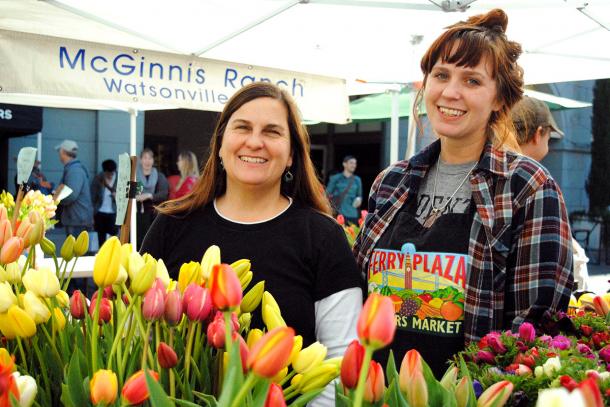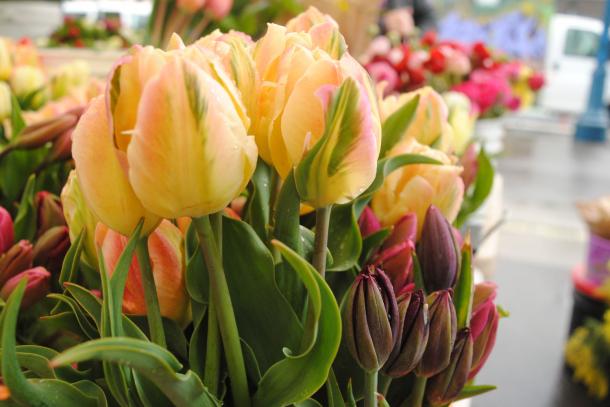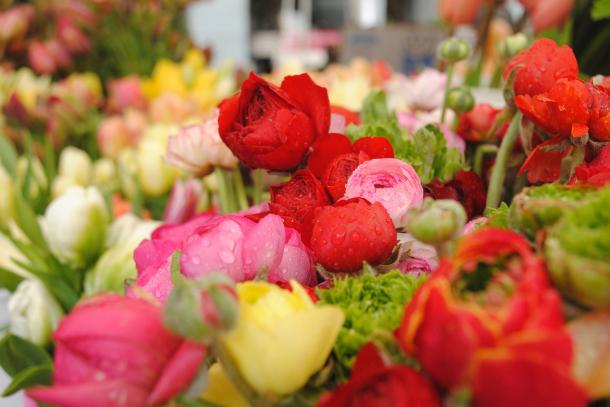True Love for Local Flowers
Brie Mazurek, CUESA Staff
February 11, 2022
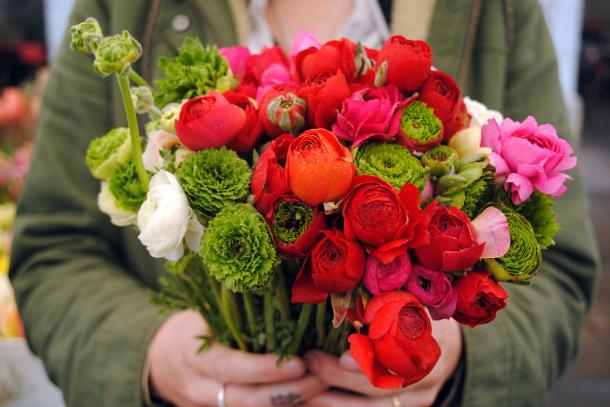
Though many of us think about local and organic when it comes to the food we put in our bodies, we may not think about the origin or environmental impact of the flowers we give to our loved ones on Valentine’s Day. Every rose has its thorn—and it probably comes with a heavy carbon footprint, too.
“People who buy their produce locally don’t necessarily realize that buying local flowers is just as important,” says Sandi McGinnis-Garcia of McGinnis Ranch, who grows both food and flowers in Watsonville.
Since trade agreements relaxed tariffs on South American products in the 1990s, American growers have faced stiff competition from growers in Colombia and Ecuador, where flowers can be grown with cheaper labor and looser pesticide regulations. Today, the U.S. imports upwards of 80 percent of its cut flowers.
This Valentine’s Day, you can show your love for local farmers, farmworkers, and the environment by ditching the long-stem roses, thorns and all, and picking what’s fresh and in season.
No Bed of Roses
Thanks in part to the farmers markets movement, American flowers have experienced a small resurgence in recent years, with California growers supplying 75 percent of domestic cut flowers. But according to the California Cut Flower Commission, only about a third of American households buy cut flowers regularly, and 85% do not know where their flowers come from.
Now in their fourth generation of farming, the McGinnises have weathered the ups and downs of the local flower industry over the last few decades. In addition to stone fruit, Sandi’s grandmother grew daffodils to sell in the wintertime. When Sandi’s father, Howard, took over in the farm in the 1960s, he shifted the farm’s focus to vegetables.
In 1982, before Sandi ever knew she would take over the family farm, she started a wholesale cut flower business, when there were dozens of growers in Watsonville. Over the years she began seeing the local flower farms go out of business due to overseas competition, and she approached her father to start growing flowers again, so she would have a local supplier.
Howard built his flower business primarily through farmers markets, and crop diversity has always been the key to survival. “Having flowers, vegetables, and berries helps to balance things out,” says Sandi. As produce wanes in the lean months of January and February, tulips start to bloom.
Flowers for the Seasons
McGinnis Ranch now grows hundreds of varieties of flowers to bring to farmers markets, from tulips, ranunculi, and anemones starting in late winter, to sunflowers, dahlias, and zinnias in summer and fall. Their flowers are grown outside or in hoop houses, not temperature-controlled greenhouses, so the offerings necessarily change with the seasons.
Since Sandi and her niece Sarah have taken over operations at the ranch, they’ve branched out. This winter, they planted about 50,000 tulip bulbs this winter, trying about eight different varieties a week, so that “every week people can get something different,” Sandi says.
“A lot of the flowers we’ve planted, like verbena, feed the bees in the winter,” says Sandi. “We also include some flowers that grow wild on the farm, like mustards and wild radish.” To add greenery for arrangements, they utilize trees growing on the property like eucalyptus, myrtle, pittosporum, acacia, and bay.
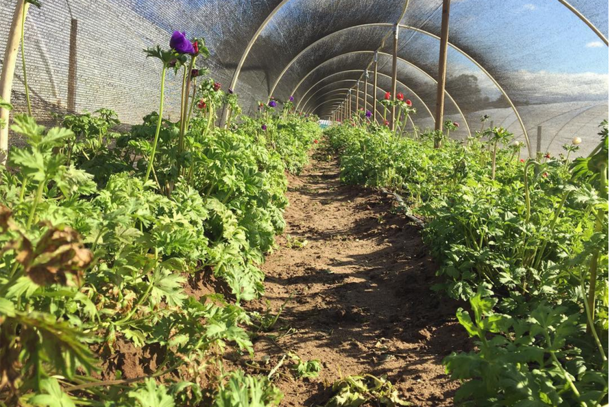
A Fresher, More Sustainable Bloom
Imported flowers are often “put to sleep” after they are harvested, packed on refrigerated trucks while they travel thousands of miles over days and across hemispheres, passing through various wholesalers’ hands before they make it to the florist or grocery store. In contrast, farmers market flowers are brought directly to the stall, which means they stay fresher longer.
At Cypress Flower Farm in Moss Beach, just a half hour south of San Francisco, farmer Randy Dardanelle picks his flowers the day before market. “Flowers like the climate in Moss Beach, which is similar to San Francisco,” he says. “The ocean keeps it from getting very cold or very hot.”
While Cypress Flower Farm is not certified organic, Randy eschews the use of harmful chemicals, and controls weeds with noninvasive methods like mulching and hand and machine cultivation. Wildlife like frogs, foxes, herons, and red-tail hawks make their home on the farm.
McGinnis Ranch received their organic certification in 2019, which required a transition period of three years of practicing organic methods. Growing flowers sustainably means that the workers who tend the fields won’t be exposed to toxic pesticides, nor will the groundwater and soil.
Beyond carbon footprints and farming practices, locally grown flowers also carry the story of the people behind them—generations of farmers nurturing something beautiful to be enjoyed and shared by their community. As Sandi says, “By getting a bouquet at the farmers market, you know who grew it, and it means more.”
Farm-to-Vase Valentine’s Day Picks
Here are a few seasonal blooms to sweeten your Valentine’s bouquets. You can support local growers year round by buying their flowers as a special treat; see our Flower Seasonality Chart for what’s ahead in the spring and beyond.
Tulips: Bringing vibrant colors to winter farmers market stands, there are thousands of known tulip varieties in every shade and shape, from pointed lily-style tulips to frilly parrots. These hardy winter flowers grow well in the fields and thrive in the rain. Cypress and McGinnis sell tulips on the bulb. While the bulbs can’t be replanted, the flowers will last longer, generally up to two weeks—and they provide a more natural look in the vase.
Ranunculus: Available in a rainbow of colors, these “buttercups” resemble small, round rosettes, with layers of papery, tightly clustered petals. They are also bisexual (aka “perfect”), which means they have both male and female reproductive parts.
Anemones: Members of the Ranunculaceae family, these small red, purple, and white beauties are known as “windflowers.” Their petals slowly open to reveal a dark or yellow center.
Flowering branches: Fruit trees like almonds and cherries start blooming in February. Look for branches with tiny pink and white blossoms from farmers like Devoto Orchards, Hamada Farms, and K&J Orchards.
Find McGinnis Ranch at the Ferry Plaza Farmers Market on Saturday and Tuesday. Cypress Flower Farm is at the Saturday market. For a full list of our farms that grow flowers, click here.
Hoop house photo from McGinnis Ranch.

This article was updated from a previously published version.
Topics: Farms, Flowers/trees, Holiday, Seasonal

